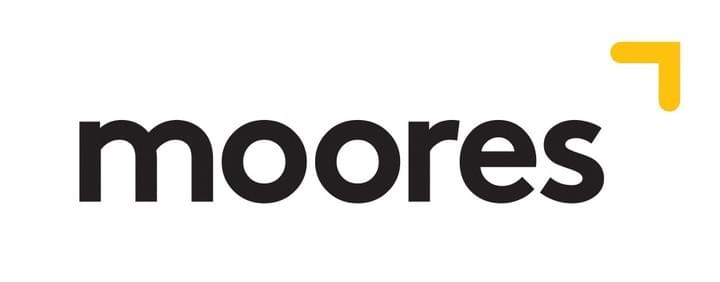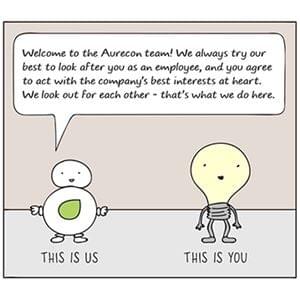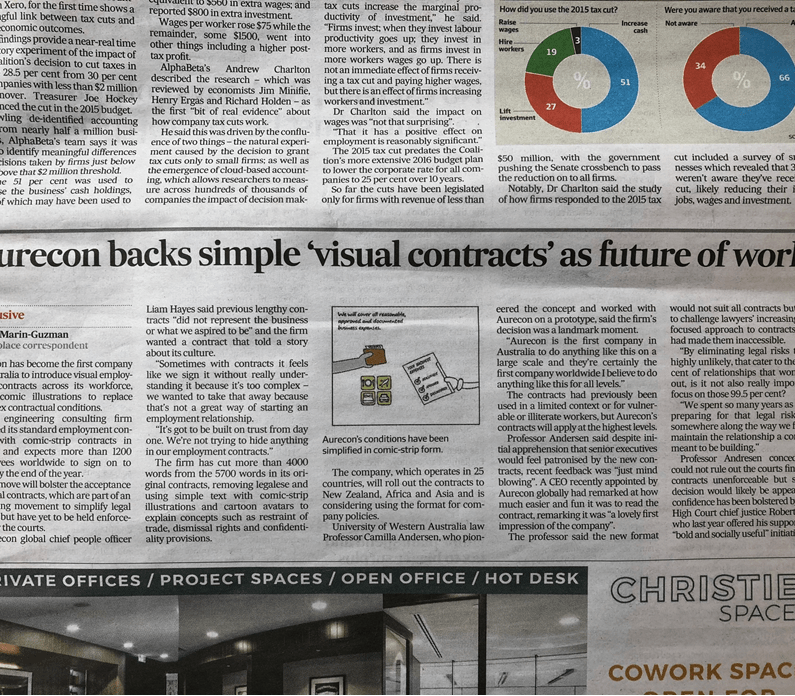



COMIC BOOK CONTRACTS
- …



COMIC BOOK CONTRACTS
- …

Seven West Media & News Corp - March 2021
"Bankwest will introduce a comic-style version of its terms and conditions in a bid to make convoluted legal clauses simpler and more engaging for customers"
To accompany the recent roll out of Bankwest's new visual terms and conditions, Seven West Media and News Corp reported on the efficacy of visual contracting in relation to customer engagement and understanding of banking products. The articles, printed under twenty nine of the media giants mast heads, with a potential audience reach of 2,846,000, discuss issues surrounding the presentation of critical information to customers and the need for clear, friendly and engaging means of communication.
Paul Vivian. Bankwest's chief customer officer stated that a vast number of customers do not engage with the legal contracts when starting up a new banking product. Mr Vivian goes on to say, "The visual T&Cs project has allowed us to reimagine how we present critical information to customers in a far more simple, friendly and engaging way to support them in improving their financial wellbeing,”
Our own Dr Andersen states in her interview, “Our research has shown that people are far more likely to engage with the comic contracts than the text-based terms, and research in psychology shows that images help people to associate and remember things better,” continuing with, “Through a tool like comic imagery, we can make contracts what they were meant to be: accessible and clear frameworks for contractual collaboration – working together, with shared understanding, and no hidden fine print.”
Find the full articles at any of the links below!

The Wall Street Journal reports on the experience of a recent Australian hire in Aurecon and her positive experience reading through and signing a comic book employment contract!
The article also touches on the thoughts of Comic Book Contract pioneers Camilla Andersen, Robert De Rooy and Thomas D. Barton. De Rooy, sceptical about conventional wordy contracts, comments upon how 'a lot of the wordage is just gunk.' In fact, de Rooy states that many of his clients report users of his comic book contracts 'experience a lot less misunderstandings or confusion.'
Andersen follows on stating that while Comic Book Contracts 'spark people's imaginations' it does not come without its own difficulties. In some instances, curating the proper visual is a task in itself. Visuals must be designed to promote inclusivity and positive values.
To read the full article click here!
Note: A WSJ subscription is required to view the entire article.
Moores provides a reviews of instances where visual contracting has been used and the organisations that support the innovative move from written contracting. In addition, like many other authors, Moores writes about complications that may arise when adopting visual contracting and scepticism by organisations such as the ACTU who state that it is ' risky for an employer to rely on a visual employment contract'. However, Moores writes that visual contracting may have a significant role in the community sector where trust is the primary factor in the relationships between contracting parties.
In particular, Moores writes that visual contracting may have special use in:
- organisation in the community sector where clients are 'not regular users of formal written contracts, have low literacy rates or disabilities, speak English as a second language or are time poor'; or
- organisations who work with children since visual contracts are more aligned with common communication methods between the younger generation (i.e emojis, gifs and pictures).
Aurecon: Aurecon RSA launches visual employment contracts - September 2018

Global engineering and infrastructure advisory company, Aurecon is using visual employment contracts from August 2018, eliminating more than 4 000 words from their employment contracts to create a succinct and meaningful visual contract that uses illustrations to complement the text.
Bartier Perry Lawyers - June 2018

Bartier Perry Lawyers talks how visual contracting is an effective medium for use in employment contracts. Employment contracts are different from most commercial contracts as they are not 'transactional in nature' but reflect a 'special ongoing relationship of trust duties of care and obligation'. The Bartier Perry article mentions the effectiveness of visual contracting in employment contracting in reflecting this this special relationship and how it may be serve individuals with visual or intellectual impairments. However, it also talks about issues that may arise with visual contracting: ambiguities in interpreting images and the existence of certain workplace arrangements that may be implied by state or common law, separate from any written intention of the parties.

Landers & Rogers weighs in on Aurecon's move into visual employment contracting writing about the issues that could be encountered by drafters and interpreters. The law firm succinctly identifies three potential issues:
- ambiguity in interpreting visual contracts;
- how a term would be defined in a visual contract and consistency in applying defined terms; and
- ensuring inclusivity and diversity in the workplace is adequately represented.

The Workplace Express write-up highlights the differing opinions on the Comic Book Contract innovation sweeping the legal industry. While employers are enthused with the initiative, other organisations such as the Australian Council of Trade Unions and Australian Industry Group express concern with the 'problems' and risks that may be associated with a visual employment contract.
Regardless, the article follows on highlighting the achievements and efforts of lawyers and academics; Camilla Andersen, Helena Haapio, Collette Brunschwig, Thomas Barton and Robert de Rooy in pushing legal innovation as seen through the Inaugural 2017 Comic Book Contracts Convention in The University of Western Australia. These rock stars are 'rattling the cage' pushing for legal innovation!

ClarkeKann Lawyers liken the Comic Book Contract movement to the next step of the plain English drafting movement. In addition to discussing the origin of the movement, they comment on the benefits and risks arising from comic contracts from a legal perspective. Comic Book Contracts provide a high level of engagement with employees. Further, they provide an alternative, effective method of communicating with employees with literacy difficulties or whose first language is not English.
However, the risk with Comic Book Contracts, as highlighted by ClarkeKann, is that Comic Book Contracts have not been tested in a court of law. As Comic Book Contracts have not been tested in court, it is uncertain how they will be interpreted. Read more here.

Pictorial Employment Contracts – a legitimate craze, or just plain crazy?
Stephen Booth, on behalf of Coleman Grieg Lawyers, writes in a blog post on Aurecon's innovative move to replace its employment contracts with a visual employment contract. The article describes the motivations behind Aurecon's move to visual employment contracting and the advantages and disadvantages behind it.
One interesting note that Booth makes is the commercial impact of moving to visual contracting. Booth notes that law firms may need to hire a resident artist in order to develop contracts in a pictorial format - unless there were any hidden artistic talents lurking amongst any lawyers!
Sign On The Dotted Line: Are 'comic book contracts' the user-friendly future?
The Comic Book Contract movement was front page news on the Irish Law Society Gazette heralded as the future of user-friendly law (there are a few mistakes in this article that the editor has been made aware of).

Our very own Doctor Camilla Andersen gets right to the brunt of it in her write up for The Conversation - pointlessly complex contracts have to stop.
To illustrate her point, Andersen draws upon the impact of needlessly verbose contracts that are impossible to understand while also highlighting how a simple three panel comic formed a full non-disclosure agreement.
Read on here to see Doctor Andersen further discuss the history of the movement and the weird and wacky terms and conditions found in conventional wordy Terms and Conditions!
Australian Financial Review
Aurecon backs simple visual contracts as the future of workplace employment contracts on Page 3 of the Australian Financial Review!

Forbes Magazine -
Comic Contracts: A Novel Approach To Contract Clarity And AccessibilityComic Book Contracts and Robert De Rooy has received further exposure in Forbes Magazine. Click here to read about it!
Aurecon - Comics and Compliance
An article written by John Callaghan of Aurecon commenting on how comic book contracts encourages innovation and the development of ideas and concepts, rather than impose unneccesary red tape barriers which traditional contracts are often guilty of.
The University of Western Australia Facebook Account
Camilla and Louis feature in a Facebook video posted in the University of Western Australia's Facebook page. In this video a law professor and a graphic illustrator explain their unlikely collaboration - to revolutionise legal contracts! As explained by Camilla, the aim of comic book contracts is to encourage users of such contracts to actually read the contract, understand the contract and remember what their contractual obligations are.















